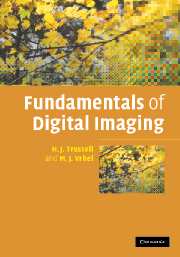Book contents
- Frontmatter
- Contents
- Preface
- Acknowledgments
- 1 Introduction
- 2 Mathematical representation
- 3 Elementary display of images
- 4 Quantization
- 5 Frequency domain representation
- 6 Spatial sampling
- 7 Image characteristics
- 8 Photometry and colorimetry
- 9 Color sampling
- 10 Image input devices
- 11 Image output devices and methods
- 12 Characterization of devices
- 13 Estimation of image model parameters
- 14 Image restoration
- A Generalized functions and sampling representation
- B Digital image manipulation and matrix representation
- C Stochastic images
- D Multidimensional look-up tables
- E Psychovisual properties
- References
- Index
2 - Mathematical representation
Published online by Cambridge University Press: 06 July 2010
- Frontmatter
- Contents
- Preface
- Acknowledgments
- 1 Introduction
- 2 Mathematical representation
- 3 Elementary display of images
- 4 Quantization
- 5 Frequency domain representation
- 6 Spatial sampling
- 7 Image characteristics
- 8 Photometry and colorimetry
- 9 Color sampling
- 10 Image input devices
- 11 Image output devices and methods
- 12 Characterization of devices
- 13 Estimation of image model parameters
- 14 Image restoration
- A Generalized functions and sampling representation
- B Digital image manipulation and matrix representation
- C Stochastic images
- D Multidimensional look-up tables
- E Psychovisual properties
- References
- Index
Summary
For any type of structured analysis on imaging systems, we must first have some model for the system. Most often it is a mathematical model that is most useful. Even if the model is simplified to the point that it ignores many real world physical effects, it is still very useful to give first order approximations to the behavior of the system.
In this chapter, we will review the tools needed to construct the mathematical models that are most often used in image analysis. It is assumed that the reader is already familiar with the basics of one-dimensional signals and systems. Thus, while a quick review is given for the various basic concepts, it is the relation between one and two dimensions and the two-dimensional operations that will be discussed in more depth here.
As mentioned, the mathematical models are often better or worse approximations to the real systems that are realized with optics, electronics and chemicals. As we review the concepts that are needed, we will point out where the most common problems are found and how close some of the assumptions are to reality.
Images as functions
Since images are the main topic of this book, it makes sense to discuss their representation first. Images are, by definition, defined in two spatial dimensions. Many, if not most, images represent the projection of some three-dimensional object or scene onto a two dimensional plane.
Information
- Type
- Chapter
- Information
- Fundamentals of Digital Imaging , pp. 8 - 44Publisher: Cambridge University PressPrint publication year: 2008
